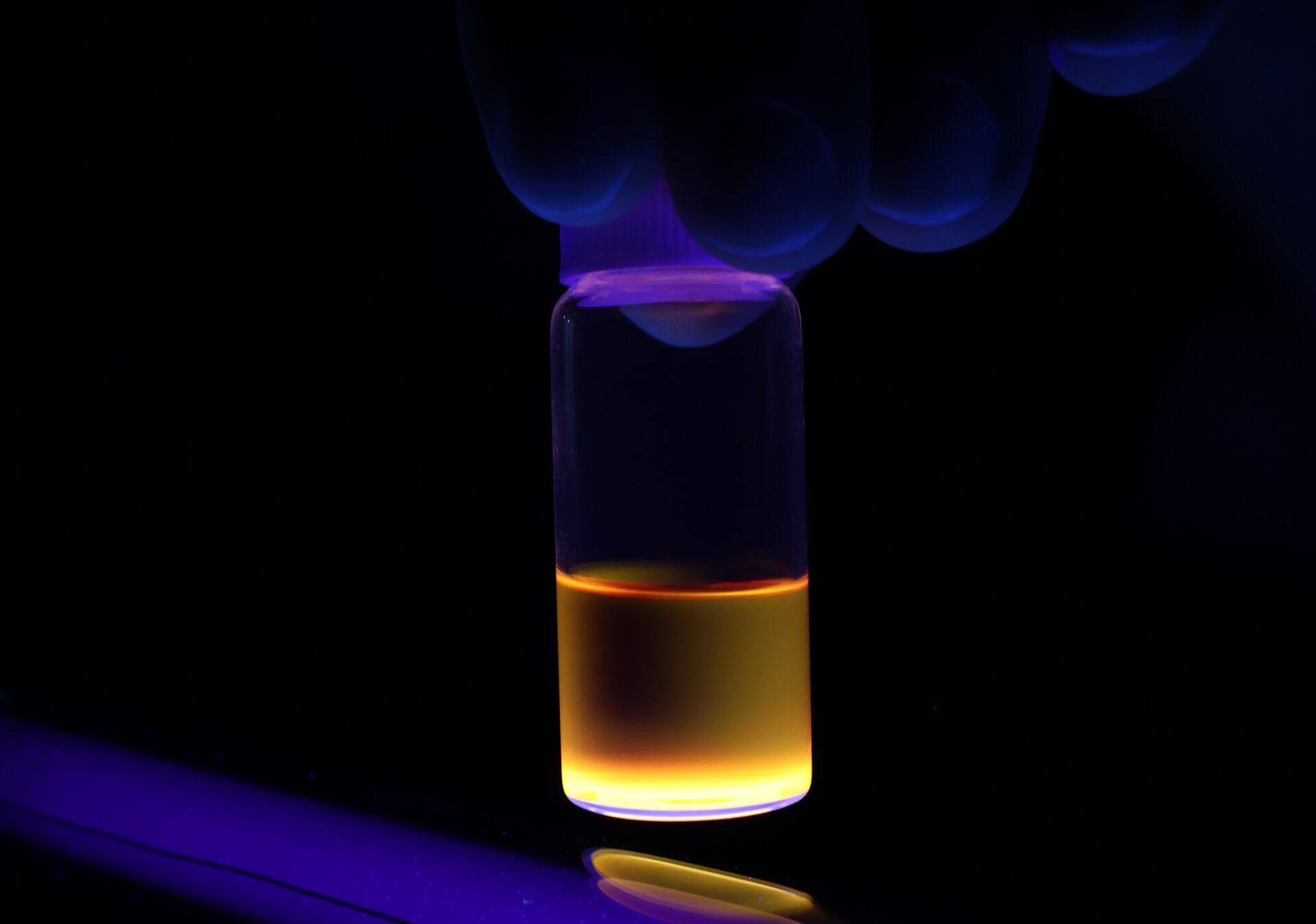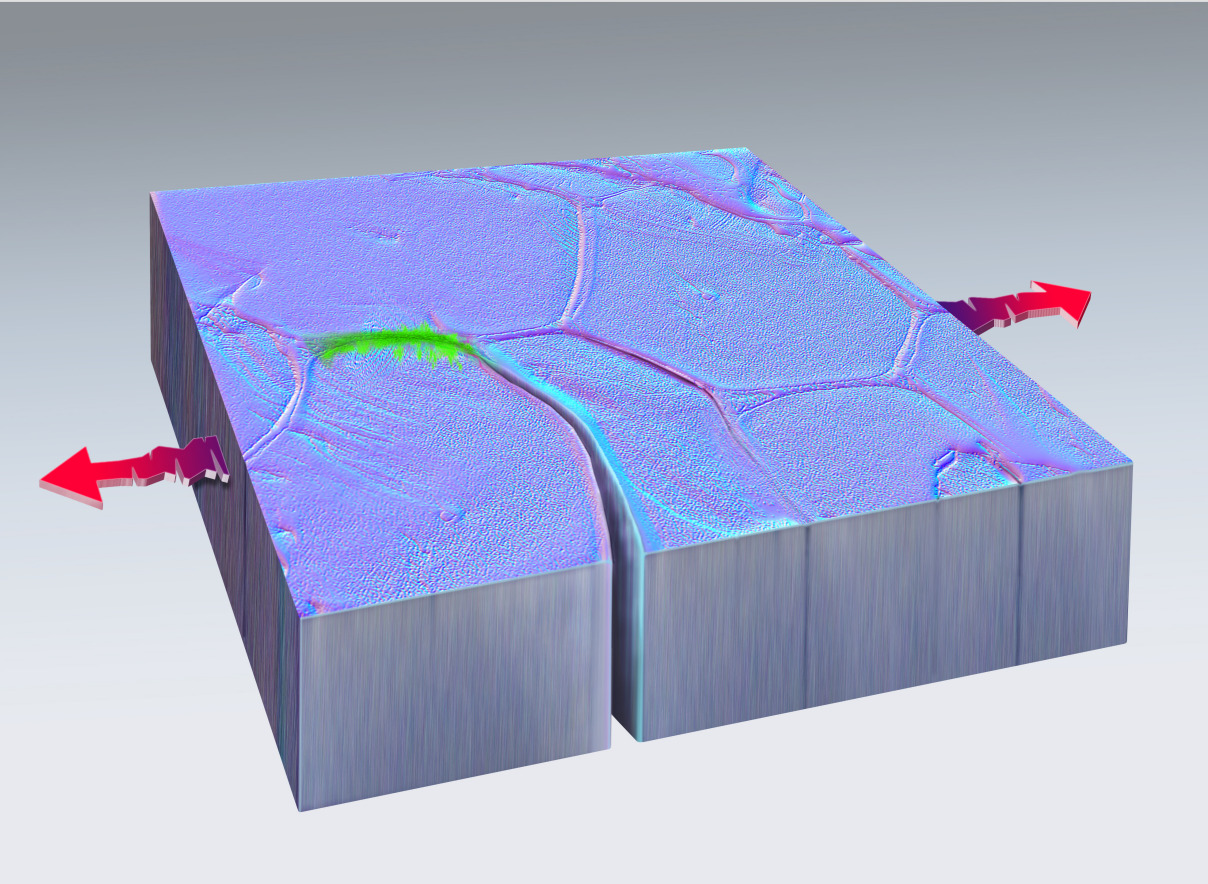
New material illuminated with ultraviolet light./ ICB-CSIC
The CSIC has created a new sustainable material that could revolutionize electronic devices. This combination of nanomaterials is a hybrid of a conductive polymer and graphene, capable of converting light into electricity and vice versa very efficiently.
The material was created by a team of researchers at the CSIC’s Institute of Carbochemistry in Zaragoza, Spain. The researchers used a process that uses water as a solvent, which is more sustainable than traditional methods that use toxic chemicals.
The material has the potential to be used in a variety of electronic devices, including solar cells, displays, and sensors. The researchers are currently working on developing the material for commercial use.
A group of researchers at the Institute of Carbochemistry (ICB) of the Consejo Superior de Investigaciones Científicas (CSIC) has made a significant breakthrough in the development of more efficient and sustainable devices. They have created a special combination of nanomaterials that can convert light into electricity and vice versa much faster than conventional materials. Their work has been published in the journal Chemistry of Materials.
“We have created a hybrid of two nanomaterials: a conductive polymer called polythiophene, in the form of 1D nanoparticles; and a 2D nanomaterial derived from graphene, graphene oxide. The unique properties it presents are very promising for improving the efficiency of optoelectronic devices such as the screens of electronic devices and solar panels, among others,” says Wolfgang Maser, ICB researcher in charge of the project.
“We have found that the synthesis strategy used to create the new material allows the polymer to adopt a special structure in the form of water-dispersible nanoparticles, which favors an intimate contact with the graphene oxide sheets,” adds Maser. This contact, in turn, generates changes in the electrical behavior of the material and makes it more electrically efficient.
“We were very interested in polythiophene because it has very advantageous optical, electrical, and electrochromic properties. When it is illuminated, it creates electricity and when it receives electricity, it produces light, but it does so very slowly,” adds Ana Benito, researcher and leader, together with Maser, of the Group of Carbon Nanostructures and Nanotechnology (G-CNN) of the ICB. This research group has been studying graphene oxide for years, a nanomaterial derived from graphene, with unique properties, dispersible in water and easy to produce. “We believed that by creating a hybrid material between the two, this problem could be solved,” says Benito.
“Our idea was to modify polythiophene by converting it into small nanometric spheres, which we call nanoparticles, which easily bind to graphene oxide. In addition, this methodology allowed us to work in an aqueous medium, which is very difficult with this type of polymers,” highlights Benito, who acknowledges that at first they did not observe any change in the electronic properties of the material. “However, upon further analysis, we discovered that the new material makes electricity travel so fast that we could not detect it with normal procedures. The collaboration with researchers from the universities of Murcia, Cartagena and Zaragoza confirmed the relevance of what we had found,” she underlines.
Technological revolution
This discovery has important implications for a variety of technological applications, such as the manufacture of flexible displays, portable electronic devices, and high-efficiency electronic paper. According to Eduardo Colom, the main author of the article and researcher at the G-CNN, “these devices would be more efficient, lighter, flexible, and sustainable compared to current ones, as they would be based on environmentally friendly materials with excellent electrical properties.” In addition, this development could also improve the efficiency of organic solar cells, which would allow for more efficient and economical solar energy capture. “Thanks to this new breakthrough, we would be talking about the possibility of manufacturing more energy-efficient devices, that is, with lower energy consumption and fast response. All this brings us closer to a future with more sustainable and advanced technology,” adds Colom.
A bet for sustainability
The new hybrid material is also sustainable because the synthesis process used to create it uses water as a solvent instead of toxic chemicals, unlike other procedures that are currently used. This could help to reduce the environmental impact of the manufacture of electronic devices. In addition, this synthesis strategy can be extended to other types of conductive polymers, with implications in a variety of technological applications. The discovery is, therefore, relevant for the sustainable design of new high-performance optoelectronic device structures.
The five researchers who make up the G-CNN have specialized in recent years in creating highly functional and environmentally sustainable nanomaterials. These nanomaterials can be used for a large number of applications, ranging from processes related to the production of clean energy – such as the production of green hydrogen, catalysis, or energy storage – to the conservation of heritage, the creation of (bio)sensors or the diagnosis and treatment of diseases.
These investigations are carried out at the ICB, a CSIC center located in Zaragoza of international reference in the search for answers to the great social and technological challenges of today, such as the sustainable generation of energy, the fight against climate change and pollution, as well as the development of nanomaterials, nanotechnology and new sustainable sensors.
Original Article: Pitt ChemE Researchers Design Active Materials for Self-regulating Soft Robots
More from: Spanish National Research Council | University of Zaragoza | University of Cartagena | University of Murcia
The Latest Updates from Bing News
Go deeper with Bing News on:
Sustainable nanomaterials
- Sustainable Investing
Not all water funds are in the same boat. A quick guide to investing in water solutions. We sell different types of products and services to both investment professionals and individual investors ...
- United Nations Millennium Development Goals
As the MDGs era comes to a conclusion with the end of the year, 2016 ushers in the official launch of the bold and transformative 2030 Agenda for Sustainable Development adopted by world leaders ...
- Sustainable Business
A logo is pictured outside the Apple Fifth Avenue store as Apple's Vision Pro headset is presented there, in Manhattan in New York City, U.S., February 2, 2024. REUTERS/Brendan McDermid/File Photo ...
- Scientists develop breakthrough gel material that could remove one of the most common pollutants — here's how it works
"We wanted to make a material that is more sustainable and can be used repetitively." Scientists develop breakthrough gel material that could remove one of the most common pollutants — here's how it ...
- New high-throughput device to unlock the potential of advanced materials
A Birmingham researcher has developed a new high-throughput device that produces libraries of nanomaterials using sustainable mechanochemical approaches.
Go deeper with Bing News on:
Optoelectronic device structures
- Scientists create black arsenic visible infrared photodetectors
Examples of such crystals include graphene, black phosphorus (BP), and transition metal dichalcogenides (TMDs). With their atomic thickness, high carrier mobility, and tunable bandgaps, ...
- Tweaking isotopes sheds light on promising approach to engineer semiconductors
Research led by scientists at the Department of Energy's Oak Ridge National Laboratory has demonstrated that small changes in the isotopic content of thin semiconductor materials can influence their ...
- Tiny, transparent chip could transform your smartphone into a professional-grade camera
Scientists built a "smart filter" that can work with a cheap smartphone camera to transform low-resolution photos into supersharp images without glare and other issues.
- Unraveling the efficiency losses and improving methods in quantum dot-based infrared up-conversion photodetectors
More sophisticated optical structure, such as micro-cavity or plasmonic structure ... as well as the device physics of CQD-based optoelectronic devices. The researches on the visible-emitting CQDs and ...
- Scientists reveal working mechanism of multilayer MoS₂ photodetector with broad spectral range and multiband response
making it a research hotspot in the field of optoelectronic detection. The performance of MoS 2 devices highly depends on their material characteristics, device structures, and fabrication techniques.









